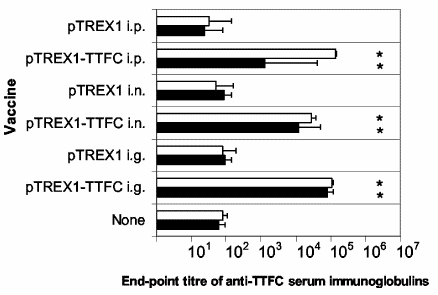Humoral Response to Tetanus Toxoid
Route of Immunization Affects Antibody Production
Tetanus toxic fragment C (TTFC) is a heavy chain component of tetanus toxin that can be used for immunization and protects mice against a lethal challenge with tetanus. In a study by Robinson et al. (2004), mice were immunized with Lactococcus lactis bacteria expressing TTFC via three different routes: intragastrically (i.g.), intranasally (i.n.), and intraperitoneally (i.p.). Results indicated that TTFC-specific IgG levels in mouse serum increased significantly after administration of L. lactis in all three routes, with the highest increase in antibody titers seen after i.p. injection.
Upon immunization with TTFC, mice were found to produce predominantly IgG1 and IgG2a antibodies, while the levels of IgGb2 and IgG3 were not significantly higher than in the control group. IgG1 and IgG2a were produced in approximately equal levels for mucosal immunization, but IgG1 production dominated in the interaperitoneal route (Figure 1). Such results indicate that tetanus toxin evokes a mixed Th1/Th2 T-cell response. Additionally, all three routes showed an increase in the level of IgA-secreting cells and TTFC-specific IgA antibodies (Robinson et al., 2004).
 |
Figure 1. Serum TTFC-specific IgG1 and IgG2a antibody levels in mice immunized with TTFC-expressing L. lactis. Open bars = IgG1, solid bars = IgG2a. pTREX = control group, pTREX1-TTFC = TTFC-expressing group (Robinson et al., 2004) |
DNA Versus Protein Immunization
In a study by Anderson et al. (1996), mice were injected intramuscularly with either purified TTFC or TTFC-expressing plasmid DNA. Results indicated that IgG2a production dominated the DNA immunization method, whereas IgG1 dominated the protein immunization method (Figure 2). Protein immunization was shown to induce higher antibody titers than DNA immunization, but both methods were sufficient to protect mice against a lethal challenge with tetanus toxin.
Since IgG2a antibodies are dependent upon IFN-γ production, it is believed that a Th1-type (cell-mediated) response is produced as a result of the DNA vaccination route. Such a result may be useful for determining future methods for combating intracellular bacterial pathogens.
Figure 2. Serum antibody levels in mice immunized with either purified TTFC or TTFC-expressing plasmid DNA. OD490 = optical density of serum sample. |
This web page was produced as an assignment for an undergraduate course at
Davidson College.
Contact: cahermes@davidson.edu